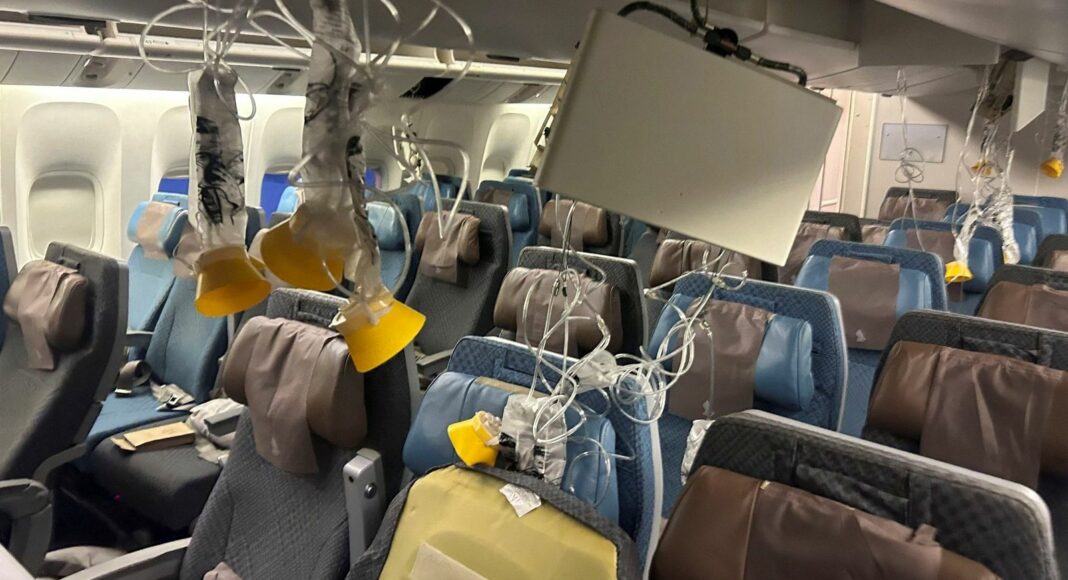Severe turbulence struck a Singapore Airlines flight from London Heathrow earlier today, with one man killed and many others “launched into the ceiling”.
Authorities believe a 73-year-old British man, who had a heart condition, likely died from cardiac arrest, with at least 30 others injured as a result of the turbulence.
Deaths from turbulence are extremely rare, and the US’ Federal Aviation Administration (FAA) said 146 passengers and crew have been seriously injured by turbulence between 2009 and 2021.
Read more:Images show damage in plane after one killed in turbulence
But what could have caused the incident, what types of turbulence exist, and are the events getting worse? Here’s what experts have said so far:
Image:
Pic: Reuters
What does the flight data show?
Flight data shows a spike in altitude of around 275ft (84m) at 2.49pm local time. Shortly after, the plane returned to a cruising altitude of around 37,000ft (11,277m).
According to Flightradar24, “the flight encountered a rapid change in vertical rate, consistent with a sudden turbulence event”.
At 3.03pm local time, the flight changed course and began its diversion to Bangkok.
Around 20 minutes later, at about 3.25pm, the flight declared an emergency – a Squawk 7700 – before landing in Bangkok at 3.45pm.
Image:
Source: Flightradar24. All times are local
What could have caused the turbulence?
Tim Atkinson, an aviation consultant and pilot, told the Sky News Daily podcast he believes “it’s fairly clear” the Singapore Airlines flight “encountered atmospheric turbulence”.
He noted that the area – called the Intertropical Convergence Zone – where the Boeing 777 plunged 6,000 feet is “renowned among pilots, and I dare say passengers, for turbulence”.
“Despite abundant caution occasionally, there’s turbulence ahead which can’t be identified, and the unfortunate result of an encounter is injury and, very rarely, fatality,” he said.
Mr Atkinson also noted that the larger the aircraft, “the worse the atmospheric perturbation, the disruption in the smoothness of the atmosphere, needs to be to cause major problems”.
He then said the 777 is “one of the largest and, I daresay, most solid airframes widely flying around the world”.
Image:
Pic: Reuters
What types of turbulence are there?
Sky News’ weather producer Jo Robinson notes there are a few forms of turbulence – where there’s a sudden change in airflow and wind speed.
Turbulence can often be associated with storm clouds, which are usually well forecast and monitored, allowing planes to fly around them.
Clear-air turbulence (CAT) is much more dangerous as there are no visual signs, such as clouds.
This invisible vertical air movement usually occurs at and above 15,000ft and is mostly linked to the jet stream.
There are clues on where CAT may occur, but generally it can’t be detected ahead of time, which means flight crews can be caught unaware with no time to warn passengers and put seat belt signs on.
It is unclear what type of turbulence the Singapore Airlines flight went through.
How common is an incident like this?
Chris McGee, a commercial pilot for more than 20 years, said in her experience the plane did encounter CAT which is “almost impossible to predict” and comes “out of the blue”.
Ms McGee said turbulence is not in fact that rare, but to experience it to this degree is “phenomenally rare”.
“In my career I’ve experienced one incident of severe turbulence,” she said, adding that she has heard of maybe “two, possibly three incidents of something that extreme” from fellow pilots.
The reported 6,000-ft drop in under five minutes is quite normal in a controlled descent instigated by the pilot, she said.
However, what they experienced was not a nice smooth, controlled descent, but an “absolute maelstrom of the aeroplane flinging itself around all over the sky”.
“It’s awful what happened to those on board, one death is tragic, other people were injured, but something like that is incredibly rare,” she said.
“We do train in the simulator every six months at least where we practicse things we can’t practise in the real aeroplane. Things like emergency procedures, abnormalities and unusual weather conditions like this, for example.
“We are taught how to fly the aeroplane through these extreme events and how to recover them should the plane depart from its normal flight mode.”
Her best advice for any passengers concerned about their safety on the flight is to follow what the cabin crew “strongly suggest and keep their seatbelts loosely tied at all times. On the flight deck that’s what we do. It will protect you”.
Image:
Pic: Reuters
Is turbulence getting worse?
It’s been understood for some time that climate change is increasing turbulence during flights, and the trend is set to worsen according to reports.
In June last year, a study from Reading University found that in a typical spot in the North Atlantic – one of the world’s busiest routes – the total annual duration of severe turbulence increased by 55% from 17.7 hours in 1979 to 27.4 hours in 2020.
Moderate turbulence was also found to have increased by 37% from 70.0 to 96.1 hours, and light turbulence increased by 17% from 466.5 to 546.8 hours.
Follow Sky News on WhatsApp
Keep up with all the latest news from the UK and around the world by following Sky News
Tap here
Professor Paul Williams, an atmospheric scientist who co-authored the study, said at the time: “My message from this is we need to do something otherwise flights will become more turbulent in future [as global heating increases further].”
Professor Paul Roundy, from the University of Albany, said on X on Tuesday that the 55% increase in “a very infrequent signal gives a real, but small, change in absolute risk”.
He noted that “it’s not something a randomly selected passenger should worry about,” before adding: “Airline travel of the future won’t be fraught with wings ripped off planes, or have thousands of dead or injured passengers.
“It will mostly look like it does today.”




